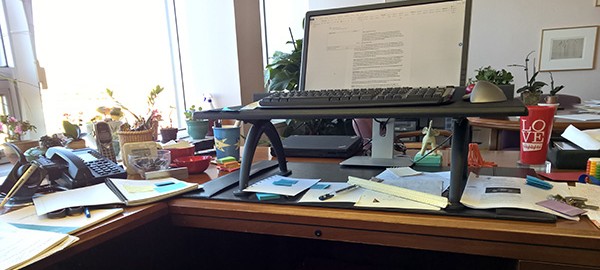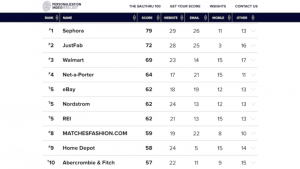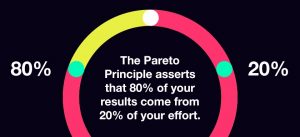Earlier this month, I had a funny correspondence with a favorite client. He claimed to have returned from vacation “to a clean desk with a relatively clear mind.” I gave him full credit for his clear mind, but I teased him about the clean desk because he’s often in the middle of several projects at once, and his desk is usually piled with documents and publications.
In reply, he sent me a photo of what really was a pretty bare desk. So I responded with this photo:

A Messy Desk Can Be a Garden for the Mind
The truth is, I don’t work tidy either. I’m usually reading several online articles, consulting at least a couple of books, a dictionary, and a thesaurus), as well as paging through a notebook of notes from my most recent client visit or call, in preparation for a follow-up email. And the radio is probably on. This is the feeding stage.
It’s followed by the breeding stage, which is an unconscious but intentional building of a logjam: the percolating and bottlenecking of lots of thoughts. They may be multipart observations, trial solutions, quick plans, or blog topics — and they all come rushing down the chute at once.
Next, I take the logjam apart and actually look at the ideas in some depth. “Logs” might float to the surface in bunches or pop up one at a time to be examined, sequenced, and shaped. And that’s the weeding stage.
At this point, I might have the spine of a set of recommendations for a client, opening paragraphs for one or two more blogs, or even a conviction about something I need to do for my business, my family, or myself. Now I can clear the decks a bit and actually get down to work on one of these things, turning it into the beginning or kernel of a whole project, publication, or initiative — the seeding stage.
Grounds for Creativity
It turns out that my process matches the current scientific data. A small study conducted at the University of Minnesota in 2013 (and subsequently confirmed by researchers at Northwestern University) showed that disorder nudges creativity. A little mess signals that the normal, status-quo rules have been suspended.
On the other hand, if you need to meet a deadline, edit a report, verify statistics, or come to a quick and well-defined decision, then tidy is the way to go. Everyone’s different, but for most of us, a cleared desk is a better environment for compliance and productivity than it is for idea generation.
What’s on Your Desk?
Well-rounded creatives and business types alike need to do both creative and decisive thinking, so there’s no need to be too proud in either direction. Sometimes we all benefit from a little clutter; sometimes we need to clear the decks. And for some people, neat doesn’t mean a pristine workspace with everything set at right angles, it’s just about knowing exactly what’s in each pile and having one clear spot for the current project.
In any case, don’t go beyond what’s socially acceptable in your work culture: If you’re situated in an open office, lots of papers lying around can make you look nutty. But if you stack your documents, clear away the old coffee cups, and put out some cheery post-its and funky desk toys, everyone will be comfortable with all the stages of your thinking process.
Business & Finance Articles on Business 2 Community(44)









